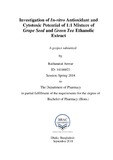| dc.contributor.advisor | Anwar, Raihanatul | |
| dc.contributor.author | Anwar, Raihanatul | |
| dc.date.accessioned | 2018-11-28T05:57:26Z | |
| dc.date.available | 2018-11-28T05:57:26Z | |
| dc.date.copyright | 2018 | |
| dc.date.issued | 2018-09 | |
| dc.identifier.other | ID 14146023 | |
| dc.identifier.uri | http://hdl.handle.net/10361/10886 | |
| dc.description | This project report is submitted in partial fulfilment of the requirements for the degree of Bachelor of Pharmacy, 2018. | en_US |
| dc.description | Catalogued from PDF version of project report. | |
| dc.description | Includes bibliographical references (page 65-71). | |
| dc.description.abstract | Grape seed extract and Green tea (also known as Camellia sinensis) are two very common plants extracts that have been generally used in several food and beverage applications. Due to the health benefits associated with them, makes them a popular choice for our study. From various literature reviews, it has been revealed that these plants exhibit properties such as anti-oxidant, hypoglycemic, anti-microbial, anti-cancer, anti-smoking, have food safety applications and also provide synergistic effects when consumed with certain drugs such as 5-Fluorouracil. Since no in-vitro antioxidant and cytotoxic potential studies were carried out with the 1:1 mixture of grape seed and green tea extract in ethanolic solvent, this study was designed to observe whether their anti-oxidant potential and cytotoxic activity increases due to synergistic effects or not. Firstly, phytochemical screening revealed that the Grape seed extract (GSE) did not exhibit alkaloid and glycosides. Similarly, Green tea extract (GTE) showed the absence of alkaloid, saponin and glycosides. For better understanding of the antioxidant potential of 1:1 mixture of GSE and GTE, several in-vitro antioxidant tests were carried out. The DPPH free radical scavenging assay denoted that 96.42% of inhibition of free radicals was evident at 1200μg/mL of the extract. The IC50 was found to be 75.86μg/mL for the plant extract, whereas the IC50 was found to be 84.783μg/mL for the standard ascorbic acid which indicated that the extract exhibited more anti-oxidant activity than the standard. The Total Phenolic Content (TPC) was found to be 122.87 mg of gallic acid equivalent (GAE)/g at 1200μg/mL. The Total Flavonoid Content (TFC) and the Total Antioxidant Capacity (TAC) was found to be very low. Therefore, overall anti-oxidant potential was moderate. Cytotoxic activity was examined using an in-vitro cytotoxicity screening method known as MTT assay on cervical cancer cell line (HeLa). The results indicated that highest percentage of cell growth inhibition was seen for 2.5mg/mL concentration of sample in which about 37.97% of cell growth was inhibited giving IC50 value of 8.1 mg/mL. To conclude, it can be inferred that due to absence of synergistic effect, the ethanolic extract of 1:1 mixture of grape seed and green tea showed weak cytotoxic effect and moderate antioxidant potential. | en_US |
| dc.description.statementofresponsibility | Raihanatul Anwar | |
| dc.format.extent | 71 pages | |
| dc.language.iso | en | en_US |
| dc.publisher | BRAC University | en_US |
| dc.rights | BRAC University project reports are protected by copyright. They may be viewed from this source for any purpose, but reproduction or distribution in any format is prohibited without written permission. | |
| dc.subject | Antioxidant | en_US |
| dc.subject | Cytotoxic potential | en_US |
| dc.subject | Grape seed | en_US |
| dc.subject | Green tea | en_US |
| dc.subject.lcsh | Antioxidants | |
| dc.title | Investigation of in-vitro antioxidant and cytotoxic potential of 1:1 mixture of grape seed and green tea ethanolic extract | en_US |
| dc.type | Project report | en_US |
| dc.contributor.department | Department of Pharmacy, BRAC University | |
| dc.description.degree | B. Pharmacy | |

